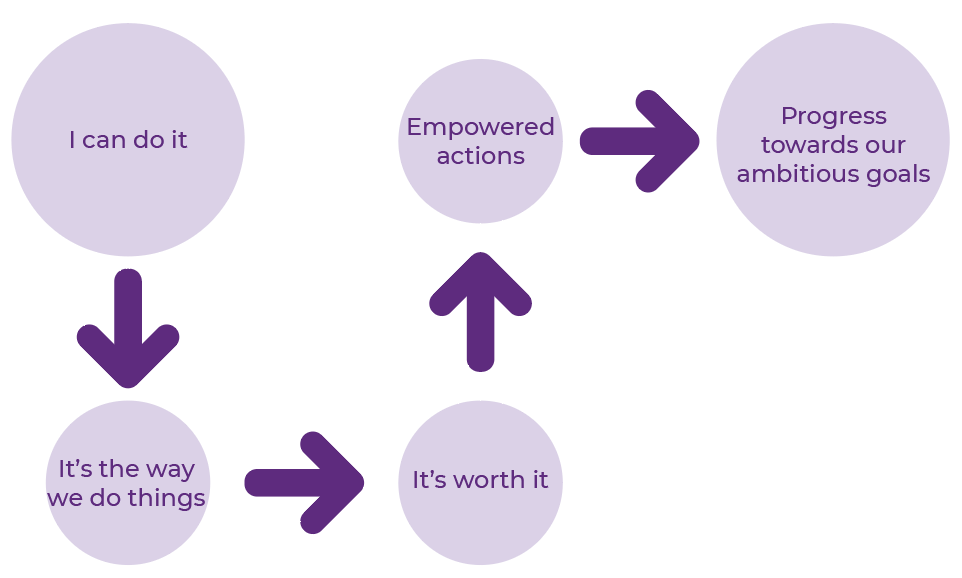Posted in Blog, Create, Grow, Lead by Jo North
How to Set Your Business Goals for Innovation and Growth
Setting robust business goals for innovation and growth is a cornerstone of any successful enterprise. This guide offers insights into the different types of innovation, how to set and achieve these goals, and how to foster a culture of innovation that fuels long-term success. Dive into this rich exploration of business innovation strategies and discover how to elevate your business potential.
Navigating Continuous Improvement and Expansion
The cycle of improvement and growth is an ongoing journey that isn’t confined to a specific time of the year.
The concept of New Year’s Resolutions and the start of a fresh calendar year often trigger a wave of goal-setting. But it’s crucial to understand that the momentum for innovation and progress should be maintained all year round.
The fiscal year, widely adopted by numerous publicly traded companies in the United States and a majority of large businesses in the UK, also serves as milestone. However, the opportunity for reflection and forward-thinking isn’t exclusive to these annual moments.
It’s crucial to treat every day as a fresh start. An opportunity to reflect on the lessons learned and achievements earned. This constant appraisal and recalibration is what fuels the strategic planning for continuous innovation, growth, and success.
Why Having Business Goals is Important
Research reveals that a significant proportion of us may fail to accomplish our set goals and targets. This is irrespective of the time of year that we set those goals and targets.
Current trends like choosing an annual theme, creating a bucket list, writing down anticipated highlights, and monthly challenges show this.
However, don’t let these statistics or the evolving trends deter you from laying down your professional and business objectives. Here’s why:
- Goal setting for business is effective. Possessing a clear, compelling objective steers your attention toward actionable conduct, irrespective of the season.
- Witnessing tangible progress toward your goals is inspirational. It generates a positive feedback loop of proactive action that operates all year round.
- Striving for ambitious objectives fosters learning and adaptability, critical elements for any business at any time.
- Fulfilling goals bolsters your self-confidence, instills a sense of achievement, and provides a cause for celebration, regardless of the calendar date.
For some reason, many of us seem to commit more profoundly to our business objectives than to personal ones. Business goals often feel more formal and mandatory, less optional compared to some – but not all – personal goals. This attitude transcends temporal constraints, making every moment an opportunity for growth and progress.
Effective Goal-Setting
Not all goal-setting is equally effective. Knowing how to set the right goals, and how to best achieve them, takes time, practice, insight and support.
My Idea Time programme, which I have published as a Kindle book on Amazon, has been helping entrepreneurs, leaders and managers to successfully achieve their big, ambitious business goals.
If you’d like to hear from just a few of the people who have used my Idea Time programme to take their business to the next level, tune in to my podcast episodes. For example:
- Andrew Palmer, from the Gravitas Matrix, left his corporate career to set up his own successful consultancy.
- Andy Firth, director of digital marketing agency Ascensor, significantly expanded his company and moved to brand new, bigger and better located premises.
- Anthony Main has grown his company, The Distance, and strengthened its position as one of the UK’s leading app development agencies.

Effective Goal-Setting for Business Growth and Innovation
I want to share some of my tips and techniques with you for effective goal-setting. If you don’t set goals that are meaningful and motivational to you, then you’re setting yourself up to fail from the beginning.
Insights from Behavioral Science
Based on studies by Icek Azjen and others, to follow through and act on an intention, we need to firmly believe these three things:
- That we are capable of achieving our goals. And even if we haven’t worked out how we are going to achieve them, we need to have the self-belief to know that what ever happens we have what it takes to work it out and make our goals happen. This particular form of self-belief is called self-efficacy.
- That what we are planning to do has a place in our social environment. That is to say, that the people who matter most to us are accepting, and preferably supportive, of what we want to go for and achieve.
- That the final outcomes will be worth all the effort we will need to invest in attaining our goals.

Unlocking Business Potential through Continuous Innovation
Embracing new ideas and innovative solutions is key to remaining competitive in the ever-evolving business landscape. From introducing new products to exploring new markets, effective innovation strategies can significantly boost a company’s market share. Business leaders have leveraged innovative ideas to revamp their business model and reinforce their value proposition, ultimately leading to improved customer satisfaction and long-term success. Examples are Microsoft and Google, with their respective AI products, ChatGPT and Bard.
The Different Types of Innovation
The innovation process encompasses various types of innovation – incremental innovation, radical innovation, business model innovation, disruptive innovation, architectural innovation, and open innovation, to name a few.
Incremental innovation focuses on improving current products or processes.
Radical or disruptive innovation introduces completely new concepts that redefine business norms.
Architectural innovation alters the way existing products or services are organised.
Open innovation encourages a culture of innovation, drawing in great ideas from external sources, such as customers and key stakeholders. The Internet of Things (IoT) and Artificial Intelligence (AI) are good examples of disruptive innovation and technological innovation, respectively.
Setting Business Goals for Innovation and Growth
Embarking on an innovation journey begins with a clear vision and setting business goals for innovation and growth. The first step is understanding the needs of your target market and existing customer base. This understanding can be achieved through market research, customer feedback, and studying customer markets. The second step involves generating innovative ideas to meet these needs. Whether it’s creating new business models, launching new products, or improving existing ones, this step requires creative thinking from all team members.
The Role of Cross-functional Collaboration
Innovation efforts should not be siloed within business units but should involve cross-functional collaboration. The importance of innovation in business success needs a common innovation mission. This mission needs to align with the company’s strategic goals and overall business strategy. Innovation initiatives should therefore be part of a broader innovation system, underpinned by an innovation culture that promotes constant innovation.
Senior Management’s Crucial Role
Senior leaders and senior management have a crucial role in fostering this culture of innovation. By setting the strategic approach and defining the innovation objectives, they can guide the innovation work and ensure that everyone – from product development teams to other business units – works towards common goals. A successful innovation strategy also recognises the real value of intellectual property and how it can offer a competitive advantage.
Investment and Long-term Success
Innovation investments are essential for facilitating the innovation process, and these should be allocated wisely to provide the best value. This could mean investing in new technologies, product teams, or even creating an innovation engine to systematically generate and implement innovative ideas.
While short-term gains from such innovations are essential, the best way to ensure sustained growth and expansion is by focusing on long-term success. This involves regularly reassessing innovation strategies and making incremental improvements to meet evolving customer needs. Best practices suggest that maintaining a balance between meeting immediate customer needs and investing in disruptive innovation for future growth is key when setting business goals for innovation and growth.
Implementing Successful Innovation Strategies
A successful innovation strategy, therefore, demands a clear understanding of your current competitive landscape, potential customers, and different markets. It also necessitates an effective strategy for managing innovation efforts, one that is adaptable, flexible, and always aligned with the organisational goals.
Innovation is not just about having good ideas. It’s about transforming those ideas into real value, creating new value, and driving growth. With the right strategic approach, even the smallest innovation can lead to better outcomes and lower costs. This paves the way for business innovation that truly resonates with the customers’ needs. It will significantly contributes to the company’s core business, and underlines the importance of setting effective business goals for innovation and growth.
Set Your Business Goals for Innovation and Growth
Making sure that you set business goals for innovation and growth is crucial for your company’s continued success in this fast-paced business environment. At the Big Bang Partnership, we’re here to help you formulate effective innovation strategies and achieve those goals.
Don’t hesitate to make the first step towards transformative business growth. Get in touch with us and discover how we can support your innovation journey. Your next big idea is just around the corner, and we’re excited to help you bring it to life.

